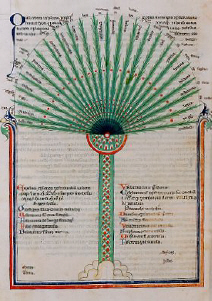Tradução da versão em inglês de MacKenna (abaixo)
2. Primeiro, então, examinemos aquelas boas qualidades pelas quais sustentamos que a Semelhança se dá, e busquemos estabelecer o que é esta coisa a qual, como a possuímos, em transcrição, é virtude mas como o Supremo a possui, é a na natureza de um exemplar ou arquétipo e não é virtude.
Devemos distinguir dois modos de Semelhança.
Há semelhança demandando uma natureza idêntica nos objetos que, além do mais, devem retirar sua semelhança de um princípio comum: e há o caso no qual B se assemelha a A, mas A é um Primal, não concernido sobre B e não afirmado assemelhar-se a B. Neste segundo caso, a semelhança é compreendida em sentido distinto: não mais buscamos pela identidade de natureza, mas, ao contrário, pela divergência posto que a semelhança advém pelo modo da diferença.
O que, então, precisamente é Virtude, coletivamente e em particular? O método mais claro será começar com o particular, pois assim o elemento comum pelo qual todas as formas mantêm o nome geral prontamente aparecerão.
As Virtudes Cívicas, que tratamos acima, são um princípio ou ordem e beleza em nós enquanto permanecemos passando nossa vida aqui: elas nos enobrecem pela fixação de limites e medidas a nossos desejos e à nossa inteira sensibilidade, e desencantar o falso juízo — e isto pela simples eficácia do melhor, pela fixação de limites, pelo fato que o comedido é elevado acima da esfera do desmesurado e ilegal.
E, além disto, estas Virtudes Cívicas — comedidas e ordenadas elas mesmas e agindo como um princípio de medida para a Alma que é uma Matéria para sua formação — são como a medida reinando no supramundo, e carregam um traço do Mais Alto Bem no Supremo; pois, enquanto a suprema desmesura é a Matéria bruta e integralmente fora da Semelhança, qualquer participação na Forma-Ideal produz certo grau correspondente de Semelhança no Ser-Aí sem forma. A participação se dá por proximidade: a Alma mais próxima ao corpo, portanto mais próxima por afinidade, participa mais integralmente e demonstra uma presença divina, quase nos enganando na ilusão que na Alma vemos Deus inteiro.
Este é o caminho no qual homens das Virtudes Cívicas alcançam a Semelhança.
Versão inglesa de MacKenna
2. First, then, let us examine those good qualities by which we hold Likeness comes, and seek to establish what is this thing which, as we possess it, in transcription, is virtue but as the Supreme possesses it, is in the nature of an exemplar or archetype and is not virtue.
We must first distinguish two modes of Likeness.
There is the likeness demanding an identical nature in the objects which, further, must draw their likeness from a common principle: and there is the case in which B resembles A, but A is a Primal, not concerned about B and not said to resemble B. In this second case, likeness is understood in a distinct sense: we no longer look for identity of nature, but, on the contrary, for divergence since the likeness has come about by the mode of difference.
What, then, precisely is Virtue, collectively and in the particular? The clearer method will be to begin with the particular, for so the common element by which all the forms hold the general name will readily appear.
The Civic Virtues, on which we have touched above, are a principle or order and beauty in us as long as we remain passing our life here: they ennoble us by setting bound and measure to our desires and to our entire sensibility, and dispelling false judgement- and this by sheer efficacy of the better, by the very setting of the bounds, by the fact that the measured is lifted outside of the sphere of the unmeasured and lawless.
And, further, these Civic Virtues- measured and ordered themselves and acting as a principle of measure to the Soul which is as Matter to their forming- are like to the measure reigning in the over-world, and they carry a trace of that Highest Good in the Supreme; for, while utter measurelessness is brute Matter and wholly outside of Likeness, any participation in Ideal-Form produces some corresponding degree of Likeness to the formless Being There. And participation goes by nearness: the Soul nearer than the body, therefore closer akin, participates more fully and shows a godlike presence, almost cheating us into the delusion that in the Soul we see God entire.
This is the way in which men of the Civic Virtues attain Likeness.
